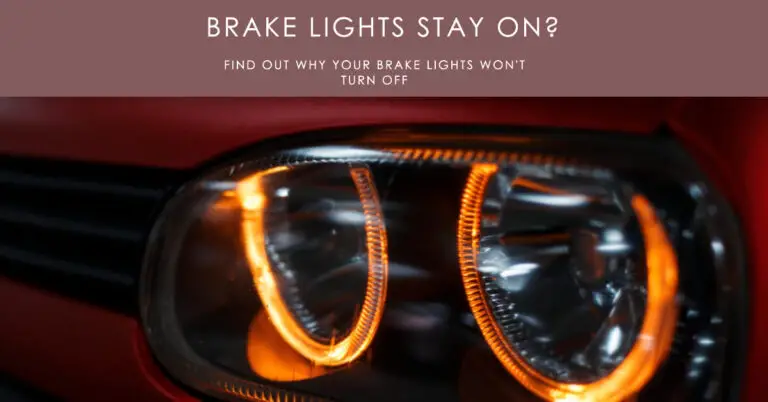Tire Pressure Warning Light On? Meaning and How to Fix It

Y’all have definitely been there before – cruising down the open road without a care in the world when suddenly an ominous orange tire pressure warning light pops up on your dashboard, killing your buzz. Ugh, what a total bummer. But don’t freak out! This handy-dandy guide’s gonna break it all down for ya – what that light actually means, what’s causing the pressure problem, and most importantly, how to get your tires back up to snuff so you can keep on truckin’ safely.
So let’s get right to it and answer the million dollar question first: What exactly does the TPMS light mean when it comes on?
In short, it means the tire pressure monitoring system (aka TPMS) in your ride has detected that one or more of your tires is low on air pressure, below the vehicle manufacturer’s recommended PSI.
The TPMS has sensors on each wheel that constantly monitor air pressure levels. When they sense underinflation, they send a signal to your dashboard to illuminate that ominous orange tire pressure light as a warning sign that you gotta get some air up in there!
Most of the times, the TPMS light is just letting you know your tires need a quick inflate to get back to optimal pressure. But sometimes, it could point to a more serious issue like a slow leak, faulty sensor, or other problem that needs addressing pronto to avoid a blowout or accident down the line!
So in summary, that bright orange tire pressure light is your vehicle’s way of saying “Yo buddy, we got an issue here with these tires that needs your attention!” Listen to it, feel me? A’ight, now that we got that covered, let’s dig into the nitty gritty…
Table of Contents
Common Causes of Tire Pressure Warning Lights
There’s a few usual suspects that’ll trigger the TPMS sensor fault warning light. Here’s the breakdown:
Underinflation
The most obvious culprit is good ol’ underinflation. Your tires naturally lose some air over time through tiny perforations in the rubber. When pressure drops more than 25% below the recommended PSI, the sensor will pick it up and flip on that orange light.
An easy fix is just to inflate ’em back up to the proper level (check your doorjamb sticker for specs). If the light comes back on shortly after, you likely have a slow leak that needs patching.
Nail or Puncture
Run over any rogue nails, screws, or sharp debris lately? They can puncture your tire and cause a slow leak, resulting in gradual underinflation and hello TPMS light. Make sure to thoroughly inspect tires for any holes or nails stuck in the tread.
Faulty Tire Pressure Sensors
Each tire has a sensor attached that monitors pressure levels. Like any electrical component, these sensors can fail or malfunction over time. A faulty TPMS sensor may misread pressure levels, causing inaccurate warning lights.
Extreme Temp Changes
Big temperature swings can potentially throw off tire pressure sensor readings. If you drive from a cold place to hot humid temperatures, the air in your tires expands and causes inflation levels to increase. The TPMS misreads this pressure flux as underinflation and triggers the warning light.
Replaced Tires/Wheels
Swapping out factory tires or wheels with aftermarket models may result in TPMS sensor issues if not properly calibrated. The sensors have to be correctly matched and synced to the new components.
Dead Battery
Sensors are powered by a small battery inside them. If the battery dies, the sensor can’t accurately measure pressure or communicate with the TPMS computer. The warning light turns on due to lack of sensor signal.
Wireless Interference
In rare cases, certain devices like LED headlights emitting radio frequencies can interfere with TPMS sensor signals and cause glitchy readings. This interference triggers faulty warning lights.
Alright, so those are some usual suspects when it comes to why that tire pressure light keeps bugging you. Next up, let’s go over…
How to Check Tire Pressure
Whenever you see the telltale tire pressure warning light, your first move should be to thoroughly check all the tire PSI readings yourself. Here’s a simple step-by-step:
Step 1 – Locate Approved PSI Level
- Check the sticker inside the driver’s side doorjamb or owner’s manual for your vehicle’s recommended tire pressure levels. This is the PSI you need to inflate to.
Step 2 – Obtain Tire Pressure Gauge
- Get a high-quality pressure gauge, either digital or manual. Make sure it’s accurate.
Step 3 – Check Each Tire Pressure
- Remove tire valve caps and place gauge firmly over valve stem on each tire, one at a time.
- Take a reading and note the PSI. Check sidewalls for max inflation levels.
- Compare readings to recommended PSI on doorjamb sticker. Identify any underinflated tires.
Step 4 – Inflate Tires
- Use air compressor to inflate any underinflated tires to the proper PSI level.
- Don’t overinflate past maximum pressure printed on tire sidewall.
- Recheck pressure with gauge to confirm accurate inflation.
Following this process allows you to get a complete picture of current tire pressure and pinpoint exactly which ones need air. Top ’em off to spec and the TPMS light should turn off once sensors sync updated levels.
But if the light comes back on shortly after inflating, you likely have a slow leak issue. In that case, it’s smart to…
Reset and Recalibrate TPMS Sensors
Recalibrating the tire pressure sensors after inflation can help determine if one is faulty or has lost calibration, which may be triggering the warning light. Here’s how to reset and recalibrate the sensors:
Reset TPMS Sensors
- After inflating tires to proper PSI, drive for 10+ minutes over 25 mph. This allows sensors time to measure and communicate updated pressure levels.
- Park and turn ignition off for 15 minutes, then restart vehicle. This resets the sensors to recalibrate and sync to new pressure readings.
Do TPMS Relearn Procedure
- Many vehicles require you to perform a sensor relearn procedure using a diagnostic tool to sync them. Check owner’s manual for instructions.
- This could include pressing on the tire valve stems in a certain order, or driving the car through specific acceleration/braking patterns.
Recheck Tire Pressures
- With sensors reset and recalibrated, check PSI readings on all tires again. The light should stay off if it was just an inflation issue.
- But if light comes back on right away or with next drive cycle, likely have a faulty sensor that needs replacement.
By resetting the onboard TPMS computer and having sensors relearn tires’ current inflation levels, you give the system a fresh start to hopefully fix any glitches trippin’ that warning light prematurely.
When to Replace a Faulty Tire Pressure Sensor
Alright, you went through the whole song and dance – checked pressures, inflated tires, did the sensor reset, but that dang TPMS warning light won’t leave you alone!
More than likely you’ve got yourself a bad tire pressure sensor that needs swapping out. Here’s signs it’s time to replace:
Light Stays On After Inflation/Resets
- If light remains on persistently even after tires are properly inflated and sensors relearned, sensor is likely bad.
Visible Damage
- Inspect sensors mounted on each wheel for visible damage like cracked/torn rubber seals. This can allow moisture damage.
Dead Battery
- Sensors have a small internal battery. If it dies, sensor fails to operate normally. Average battery life is 7-10 years.
Bad Sensor Readings
- Cross-reference sensor readings against gauge readings. If one sensor PSI is way off from gauge, could mean it’s defective.
Error Codes
- Sensor faults often store trouble codes in the TPMS computer like bad signal, no signal, etc. Diagnostic scanners can read these codes.
When you notice these signs of a faulty pressure sensor, replacement is needed for the TPMS to work properly.
Here’s an overview of the sensor replacement process:
- Order new OEM or aftermarket TPMS sensors matched for your vehicle. Reviews and brand research help find reliable options.
- Have a mechanic or tire shop install the new tire sensor on the problem wheel using specialty tools. This ensures proper mounting and sealing.
- They can also sync the newly installed sensor to the vehicle using scan tools during the reset/relearn procedure.
- Retest warning light operation after driving for sensor calibration. Light should remain off if problem resolved.
While TPMS sensor replacement costs vary depending on vehicle, genuine OEM sensors average $50-100 each. Certain luxury cars can run $200+ per sensor. The labor install ranges $50-150.
For the DIYers out there, you can absolutely replace sensors yourself as long as you have the tire change tools, diagnostic equipment, and technical know-how. But for most people bringing it to the pros will get the sensors swapped hassle-free.
Either way, replacing faulty sensors is way more cost effective than ignoring the problem and eventually having to pay for new tires or repairs from blowouts down the road!
Alright, let’s wrap this tire pressure breakdown up with some…
Frequently Asked Questions
Still have some lingering questions about what that dreaded tire pressure warning light means and how to make it scram for good? Here’s answers to some common FAQs:
Is It Safe to Drive With the TPMS Light On?
You can technically still drive a short distance if the light just came on. But it’s really not advisable or safe to go far with underinflated tires. Have it checked ASAP and inflate to proper PSI to avoid damage.
Can I Reset the TPMS Light Myself?
You can reset sensors yourself following the steps above. But if light stays on, there’s an underlying issue that needs addressing by a pro. Resets and recalibrations fix glitches but won’t repair leaks, damaged sensors, etc.
Does TPMS Drain the Car Battery?
The sensors have tiny lithium batteries that last around a decade. The TPMS itself draws very minimal power. So it’s highly unlikely the system is noticeably draining your main car battery.
Can I Drive Without Functioning TPMS Sensors?
Technically yes, but highly not recommended, and likely illegal in some states. The sensors exist as an important safety system to warn you of underinflated tires. So driving sans TPMS poses safety risks.
How Much Does It Cost to Replace TPMS Sensors?
Genuine OEM replacement sensors can run $50-$120 apiece, while cheaper aftermarket sensors typically cost $25-$60 each. Labor install fees are around $50-150 per sensor at most tire shops.
Do Tires Lose Pressure When Cold?
Yes, tire pressure drops about 1 PSI for every 10°F temperature drop. Colder temperatures mean lower pressure. That’s why the TPMS light turns on more in the winter.
Should I Reset TPMS Sensors After Tire Rotation?
Yes! Rotating tires changes their positions and which sensors correspond to each corner. Doing the reset/relearn procedure ensures the sensors properly realign with the new tire locations.
And there you have it friends – everything you could possibly need to know about what it means when that tire pressure warning light rears its ugly orange head, what may be causing the trouble, and how to banish it for good with the right repairs.
Now you can breathe easy and keep on truckin’ down the highway safely on properly inflated tires, without the anxiety of wondering when that annoying TPMS light might pop up again. Giddyup!







